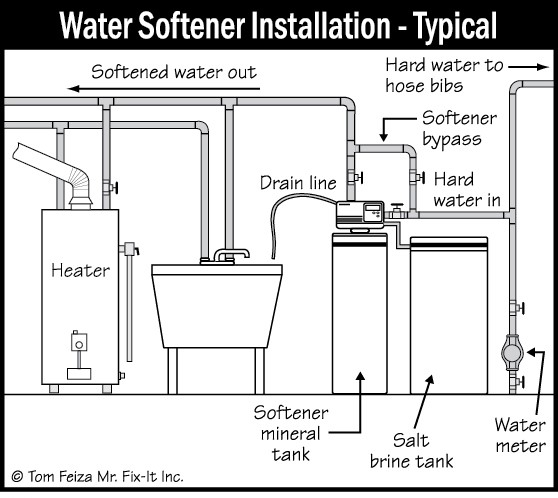More than you need to know about water softeners and water conditioners.

A typical water softener is actually pretty simple. water comes into the house through the water meter and is sent through a tank that contains resin beads. Any calcium or magnesium in the water attaches itself to those beads.
And that’s good. Those minerals tend to build up on pipes and other fixtures, eventually clogging up shower heads and shortening the life of the water heater.
And they tend to stay in your hair and clothes. So your hair is harder to clean and your towels feel stiff and rough.
At some point, however, those resin beads fill up. It’s like cleaning your glasses with a cloth; eventually that cloth needs to be cleaned. Those beads can be cleaned, or “recharged”, using brine. You know; salty water.
The resin tank has a little computer in top that measures how much water is sent through, and schedules the resin recharge based on water usage. At a certain point, usually at night, salty water is pumped through the resin tank, washing away the minerals. (Yes, a little salty water stays behind, but not much.) The brine, now full of calcium and magnesium is sent down the drain.
NOTE: Some inexpensive softeners use a time clock instead of a “Demand-Initiated” control head. These will re-generate after a certain number of days, as opposed to how many gallons of water have gone through the system. Look for a “Day” label near a wheel or dial. These units use a LOT more salt, and should be replaced. A water softener’s resin beads degrade over time, especially if you sometimes forget to replace the salt. If the unit is more than 15 years old, it is time for a new one. Be sure to get a softener that can achieve an efficiency of at least 4000 grains per pound and has settings configured to meet this efficiency.
Grains per pound means that at least 4000 grains of minerals removed for every pound of salt used. Think of MPG for car efficiency.
There is a concern with sodium-rich water being sent to our water treatment plants. Those plants do not desalinate. (That’s a fancy term meaning take the salt back out.) The environmental impact of Chloride from salt is significant. Chloride changes the respiration of plant life and can negatively effect drinking water. High-efficiency softeners use a lot less salt, and some communities are pre-softening water at the municipal level, eliminating the need for home units.
What about salt-free units, like water conditioners?
Water conditioners use magic to encapsulate the minerals. In that condition, they can not build up on pipes or in showerheads. Sometimes conditioners are called de-scalers. But water conditioners do not remove the minerals. That means that the issues with dirty hair and stiff towels remain.
The salt itself is relatively inexpensive. Use the type of salt that your particular softener manufacturer recommends. Don’t “top off” the tank; when you see water in the tank, it’s time to add more salt. Put the whole bag in, and be sure to throw away the empty bag. You don’t want salty air from the bag. The salt from the bag can rust your furnace and water heater.
I recently came across an article that is worth reading, if you want to know more about this subject. You can read it by clicking: HERE



